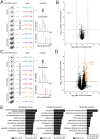This is a preprint.
Inducible protein degradation as a strategy to identify Phosphoprotein Phosphatase 6 substrates in RAS-mutant colorectal cancer cells
- PMID: 36993243
- PMCID: PMC10055397
- DOI: 10.1101/2023.03.25.534211
Inducible protein degradation as a strategy to identify Phosphoprotein Phosphatase 6 substrates in RAS-mutant colorectal cancer cells
Update in
-
Inducible Protein Degradation as a Strategy to Identify Phosphoprotein Phosphatase 6 Substrates in RAS-Mutant Colorectal Cancer Cells.Mol Cell Proteomics. 2023 Aug;22(8):100614. doi: 10.1016/j.mcpro.2023.100614. Epub 2023 Jun 30. Mol Cell Proteomics. 2023. PMID: 37392812 Free PMC article.
Abstract
Protein phosphorylation is an essential regulatory mechanism that controls most cellular processes, including cell cycle progression, cell division, and response to extracellular stimuli, among many others, and is deregulated in many diseases. Protein phosphorylation is coordinated by the opposing activities of protein kinases and protein phosphatases. In eukaryotic cells, most serine/threonine phosphorylation sites are dephosphorylated by members of the Phosphoprotein Phosphatase (PPP) family. However, we only know for a few phosphorylation sites which specific PPP dephosphorylates them. Although natural compounds such as calyculin A and okadaic acid inhibit PPPs at low nanomolar concentrations, no selective chemical PPP inhibitors exist. Here, we demonstrate the utility of endogenous tagging of genomic loci with an auxin-inducible degron (AID) as a strategy to investigate specific PPP signaling. Using Protein Phosphatase 6 (PP6) as an example, we demonstrate how rapidly inducible protein degradation can be employed to identify dephosphorylation SITES and elucidate PP6 biology. Using genome editing, we introduce AID-tags into each allele of the PP6 catalytic subunit (PP6c) in DLD-1 cells expressing the auxin receptor Tir1. Upon rapid auxin-induced degradation of PP6c, we perform quantitative mass spectrometry-based proteomics and phosphoproteomics to identify PP6 substrates in mitosis. PP6 is an essential enzyme with conserved roles in mitosis and growth signaling. Consistently, we identify candidate PP6c-dependent phosphorylation sites on proteins implicated in coordinating the mitotic cell cycle, cytoskeleton, gene expression, and mitogen-activated protein kinase (MAPK) and Hippo signaling. Finally, we demonstrate that PP6c opposes the activation of large tumor suppressor 1 (LATS1) by dephosphorylating Threonine 35 (T35) on Mps One Binder (MOB1), thereby blocking the interaction of MOB1 and LATS1. Our analyses highlight the utility of combining genome engineering, inducible degradation, and multiplexed phosphoproteomics to investigate signaling by individual PPPs on a global level, which is currently limited by the lack of tools for specific interrogation.
Figures




References
-
- Sharma K., D’Souza R. C., Tyanova S., Schaab C., Wisniewski J. R., Cox J., and Mann M. (2014) Ultradeep human phosphoproteome reveals a distinct regulatory nature of Tyr and Ser/Thr-based signaling. Cell Rep. 8, 1583–1594 - PubMed
-
- Brautigan D. L. (2013) Protein Ser/Thr phosphatases--the ugly ducklings of cell signalling. FEBS J. 280, 324–345 - PubMed
-
- Brautigan D. L., and Shenolikar S. (2018) Protein Serine/Threonine Phosphatases: Keys to Unlocking Regulators and Substrates. Annu Rev Biochem. 87, 921–964 - PubMed
Publication types
Grants and funding
LinkOut - more resources
Full Text Sources
Miscellaneous
